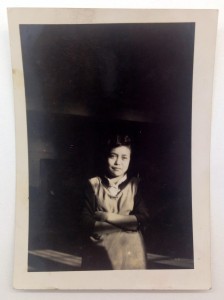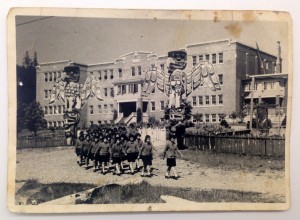In my introductory post to this blog, I included an epigraph from George Orwell’s novel Nineteen Eighty-Four:
“Who controls the past controls the future: who controls the present, controls the past.”
I thought I would briefly recall Orwell’s statement, seeing as though it is especially relevant for this week’s focus on archives within former colonial societies. As Bastian reminds us of the old cliché, “history is written by the winners” and recorded in the archive (Bastian 267). Documents in the colonial archive celebrate the exploits and conquest of the colonizers, meaning the settlers’ history takes precedence over the largely undocumented history of the natives. However, with the recent rise of post-colonial studies, scholars are endeavouring to uncover the silenced histories of First Nations communities within the colonial archive. Strategic readings of these past imperial texts were intended to unearth a new counter narrative to the archive’s more conspicuously European history. Similar to Orwell’s statement, scholars today are readjusting our understanding of the colonial past in a way that accounts for the very real histories of an entire group of people who’ve been both canonically and culturally ostracized.
Jeanette Allis Bastian and Krisztina Laszlo, two scholars of colonial or post-colonial societies, are actively searching for these silences for two reasons:
- As a way to correct injustices, vindicate the oppressed, and demystify the “winners” (Bastian 269).
- For preservation of culture; a type of anthropological salvation of a “dying culture” (Laszlo 300).
After my encounter with the archives and readings this week, I, like Bastian, am skeptical that a true and accurate account of these “subaltern” histories can derive from a colonial archive. Further, I’m unsure as to whether the museum archive is an appropriate place to “preserve” and “vindicate” these marginalized cultures. Within a conventionally established archive backed by federal institutions, these narratives are invariably and inescapably tied to a position of “otherness”.
Take for instance the Beverly Brown fonds, located at UBC’s Museum of Anthropology. Ostensibly, Beverly Brown’s photographs offer an example of a marginalized voice under colonial power that has made its way into the museum’s archive. The collection is mainly comprised of photographs documenting Brown’s experience studying at St. Michael’s Residential School in Alert Bay, BC. From roughly 1937 t0 1945, Brown photographed her friends, classmates, teachers, and the surrounding landscape. At first glance, the images are aesthetically beautiful and evident of true photographic artistry. However, when bearing in mind that the photographer who captured these moments was also a student within the residential system, one realizes the advantageous position Brown was in to portray both colonial and native experiences simultaneously.


First of all, I was struck by how happy the subjects of these photographs appeared to be. The dominant counter-narrative in circulation highlights rather the injustices, horrific conditions, and abuse the children at St. Michael’s were subjected to (Here is an article that recounts one resident’s horrific experience at the school one year after Brown had left).
However, in the Beverly Brown fonds, the children were photographed dressing up, playing games, and enjoying the outdoors. The narrative these images convey deeply complicates our general understanding of the abusive context in which these photographs were taken. Without dismissing the very abusive circumstances of these residential schools, I merely want to point out the potential difference in narrative being conveyed when looking at images of the residents photographed by white settlers, versus images captured by natives themselves. In opposition to the traditional photograph of unhappy students sitting in their desks or in a strict formation before a church, Brown’s more youthful, candid scenes of children playing outdoors challenge the colonial archives’ account of First Nations communities as victims, as the conquered and assimilated. In the Beverly Brown fonds, the children most often appear resilient, steadfast, and hopeful, standing stoically before a totem pole.

The image above is a perfect example of the two colonial narratives existing simultaneously. Here we have a residential school (a marker of colonial power), bordered by two Kwakiutl totem poles, were a group of First Nations students are marching across the front lawn.
Despite these photographs being taken by and of students in this residential school, I continually find myself wondering how much “vindication” are we actually offering these marginalized narratives if they are always understood as “other” or “counter” to the colonial narrative? The indigenous narratives documented in these archives will always be tied to the Western, colonial perspective that has enabled and called for their appraisal. While their place within the museum archival context may serve to legitimize and vocalize these previously repressed narratives, they are always understood in opposition to the colonial narrative, never fully equal. My question remains, how fully can these repressed narratives be heard in the archives of traditionally marginalized figures (such as Beverly Brown) within a colonial institution (i.e. university museum)?
Works Cited:
Bastian, Jeannette Allis. “Reading Colonial Records through an Archival Lens: The Provenance of Place, Space and Creation.” Archival Science 6.3 (2006;2007;): 267-84. Web.
Laszlo, Krisztina. “Ethnographic Archival Records and Cultural Property.” Archivaria.61 (2006): 299. Web.
